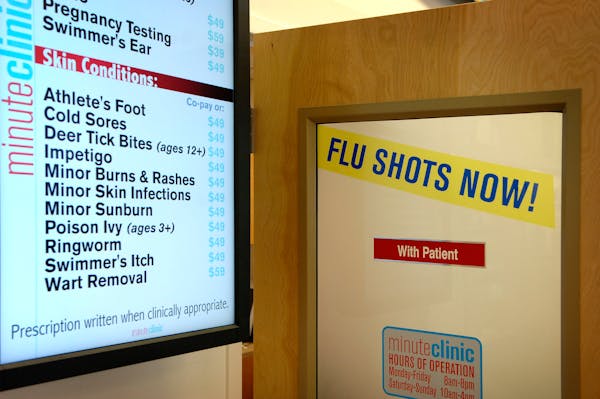A cigarette tax, a smattering of smoking bans and help in kicking the habit have converted 164,000 Minnesotans to nonsmokers since 1999.
A statewide survey of tobacco use made public today shows that 17 percent of adults smoke, down from 22.1 percent eight years before. Minnesota's steady downward trend is a sharp contrast to what has been happening nationally, where the average 20 percent of adults who smoke has not changed since 2004.
"The decrease in smoking is great news," said Dr. Marc Manley, vice president of population health for Blue Cross and Blue Shield of Minnesota. "But smoking is still the leading cause of death."
Health officials declared it a significant victory in the tobacco wars. Not only does it mean fewer people will die or suffer long, chronic illnesses, but it will eventually mean a reduction in the $2 billion annually that is spent in treating tobacco-related disease in Minnesota.
Minnesota has the fifth-lowest smoking rate in the country behind California, Utah, Massachussetts and Connecticut, according to the Centers for Disease Control and Prevention.
Reductions in smoking are difficult to achieve. The tobacco industry spends about $238 million a year in Minnesota marketing its products.
That compares to about $30 million a year spent on anti-tobacco efforts, health officials said. The state's spending may increase somewhat next year when a $47 million package of public health grants focused on obesity and tobacco is distributed across the state.
Some surprises
The survey, the third so far, is jointly conducted by Blue Cross, the Minnesota Department of Health, and ClearWay Minnesota, an anti-tobacco research and smoking cessation organization. It was conducted in early 2007, several months before the state-wide smoking ban took effect.
It asked 12,000 Minnesotans detailed questions about their tobacco habits, the influence of tobacco policies and their exposure to secondhand smoke.
What the survey found
Health officials said that they expected the increase in the cost of cigarettes, as well as other policies, would lead to a drop in smoking, but were startled by some of the findings.
• Since 2003, the smoking rate among young adults dropped a whopping 8.4 points to 28.4 percent. But the rate among those who don't go to college didn't budge, remaining at 41 percent, the highest of any group and nearly twice that of their college-going peers.
• Three percent of young adults use hookahs, water pipes used to inhale smoke.
• The 75 cent per pack tax passed by the state legislature in 2005 inspired 43 percent of smokers to think about quitting. More than a fourth tried to quit as a result of the tax and 6 percent of them succeeded.
• More than half of all smokers tried to quit in the last year. The rate of those who got help through counseling and medication increased from 3.6 percent four years ago to nearly 15 percent.
• 83 percent of Minnesotans live in homes where smoking is not allowed, up from 65 percent in 1999.
Overall, the survey documents the effectiveness of state-wide policies against smoking, officials said. That included the tobacco tax and widely available programs to help people quit smoking through counseling and medications.
Even people whose health plans don't cover cessation programs can get help for free from ClearWay's Quit Plan program.
That is one aspect that makes Minnesota unusual compared to other states, even those such as California with long-standing smoking bans.
"We have unparalleled access to quit-smoking programs," said Barb Schillo, director of research for ClearWay.
Beyond campuses
Though the state-wide Freedom to Breathe Act smoking ban took effect after the survey was conducted, 4 out of 10 people in the state lived in a city or county that had a smoking ban at the time the survey was conducted.
It also sheds light on those whose habits remain unaffected by those policies -- mostly people who are less educated and have lower incomes, especially those between the ages of 18 and 25.
Young adults are an especially important battleground. Many are still experimenting with tobacco, and have not yet become committed smokers or non-smokers. The stress of major life changes during that time makes them susceptible to marketing by tobacco companies, health officials said.
Focus on college students
Since smoking rates among young adults spiked several years ago, college campuses have become a major focus of anti-smoking efforts. Colleges have implemented smoking bans in dorms and on campus, and emphasized anti-smoking messages to their students.
It's worked. Since 2003, smoking among college students dropped from 30 percent to 23 percent. That also reflects lower rates among teenagers, which also fell from 34 percent to 23 percent in the last five years.
Fewer kids are entering college as smokers, said Pete Rode, a tobacco researcher at the Minnesota Department of Health.
"Now it's time to reach this other group," said Rode, meaning young adults who don't go to college. "But they are not as easily targeted," because they are not clustered on campuses.
They are, however, an important group to reach in order to eventually reduce the rate among older, less-educated adults. More than a fourth of those with less than a high school education smoke, compared to 6 percent with a college degree.
Josephine Marcotty • 612-673-7394

